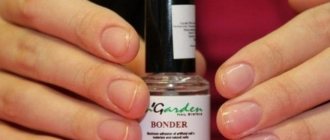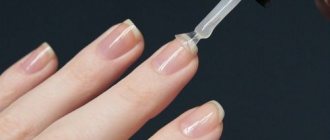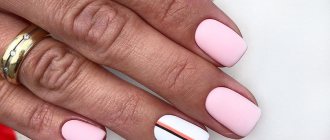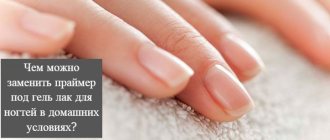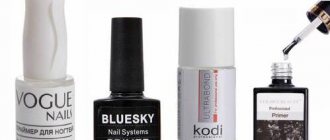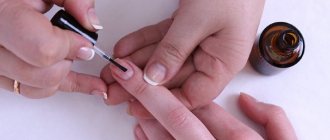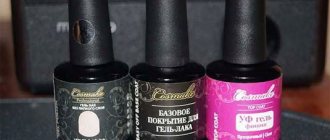The nail extension process consists of several stages. If this is your first time deciding to undergo such a transformation or you are a novice master, then you probably have many questions regarding this procedure. In this article, we will help you understand the first stage of extensions, namely the products that are used to prepare nails for acrylic or gel coating. If you started your manicure procedures with a nail bath, then after that you should not apply any oil or cream, since in order to extend your nails, they must initially be clean and dry. After the bath, you need to apply a special coating to the surface of the nail plate. But what kind of product to choose and what a dehydrator, degreaser, primer and bonder are, you will learn from this article.
Content
- Why do you need a degreaser?
- What is a primer for?
- Composition of nail primer
- Acid and acid-free primer
- Primer for gel polish and shellac
- Primer for gel nail extensions
- Primer for acrylic nails
- How to use nail primer
- What to replace the primer with?
- FAQ
primer or nail bonder is also called nail degreaser dehydrator or simply prep . In essence, these are all very similar products, differing in their composition, but used for the same purpose - degreasing the nail plate and increasing the adhesion of materials to nails during long-term coating with gel polish (shellac) or when applying nail extensions. Next, we will understand the subtleties of the differences between each of these funds and the nuances of their use.
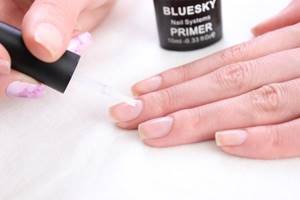
What is a bond?
A special product, a nail bonder, is used to process the plate during extensions. This composition ensures high-quality attachment of the artificial material to the nail surface. You can call it glue, which creates a base to make the manicure high-quality and durable. Masters claim that the strength of the extended nails depends on the reliability of the bond. What is a primer? This composition is applied on top of the bonder and has similar properties, but is still different.
What is a nail degreaser and dehydrator for?
Using dehydrator , the process of dehydration is carried out (hence the name) - that is, the removal of excess moisture from the surface of the nails and its deep drying, which increases the adhesion of materials (gel polish and gel) to the surface of the nail plate, which in turn increases the wear life long-term coating or artificial nails. The same process is called degreasing the nail plate, which led to the appearance of the name degreaser - it is this that most informatively displays the functions of this product. Unlike the first, the degreaser acts more superficially.
You can often find a 2 in 1 product: for degreasing nails and removing the sticky layer:
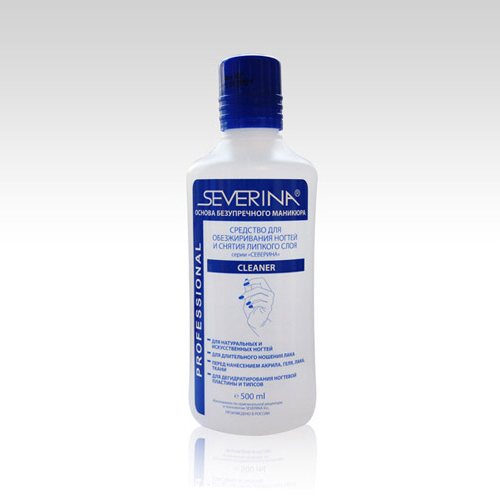
What happens if you don't degrease your nails?
A huge amount of sticky microparticles accumulate on the nails throughout the day. Some of them are invisible to the eye, but can negatively affect the durability of the manicure. The degreasing stage allows you to get rid of sebum, debris, cosmetic residues and dust that is formed while working with the file. Otherwise, all this may remain under the base and lead to detachments. Characteristic damage to gel polish begins a few days after visiting the specialist. The coating peels off along the edges of the side rollers and in the cuticle area.
Hot water, for example, washing dishes or wet cleaning, can speed up the detachment process. It may seem that it was external factors that ruined the manicure. But the culprit is insufficient treatment of nails before applying the coating. Normally, polymer compositions on nails last up to four weeks and even longer, until the next session.
Voids under the coating also increase the risk of fungal infection. Air and water enter the space between the plate and the base - the most favorable conditions for the propagation of spores. If the immune system is low, and the nails are thinned or damaged, the fungus quickly “takes over” them. It acts like an invisible enemy, because under gel polish it remains completely invisible. The infection can only be determined after removing the covering. It is important to immediately contact a dermatologist and begin treatment, which often takes several months.
What is a nail primer or bonder for?
primer also performs a degreasing function, but in addition, it improves the adhesion of the nail to the material, lifting the scales of the upper layers of the nails, and kills harmful microorganisms that can multiply under the artificial surface. Thus, in addition to degreasing, it also has a protective function.
Bonder , bond or pre-primer degreases the nail plate without affecting its deep layers and is usually used before applying an acidic or acid-free primer (or non-acidic).
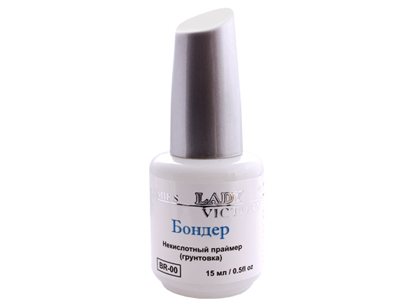
Thus, you see that the line between all these products is very thin and often everything is written on one package at once (see photo), so it is best to choose based on the condition of your nails. For example, if your nails are naturally dry, then you shouldn’t overdry them - choose a product for surface degreasing. If, on the contrary, your nails are constantly shiny, it means they are quite oily and require careful dehydration.
At the same time, there is no need to worry about the condition of the nail plate: all these products are quite gentle - they are not capable of disturbing the water balance in the nail plate, drying it out and making it more brittle.
The difference between a bond and a primer
Many novice manicurists make the irreparable mistake of replacing bonder with other products, such as primers. At their core, these substances are involved in preparing nails for further design.

But they have a different chemical composition, which is intended for a specific layer of manicure.
Distinctive features of bonds and primers:
- Structure. Primers are available in liquid form. Bonds have a thick, sticky structure.
- Primary goal. Primers of any type are used to protect the body from toxic substances entering through the nail plate. They cleanse nails of dirt, dust and grease, thereby acting as a primer. Bond mainly acts only as adhesion.
A distinctive feature between a bond and a primer is the drying process. If an ultraviolet lamp is required to dry the bonds, then the primers dry in the usual way in the open air.
Composition of nail primer
The primer is a transparent liquid that is odorless and has a consistency similar to ordinary water. It is contained in a plastic or glass bottle with a brush, similar to the brush of any varnish. The bottle is most often made opaque to ensure the safety of the product.
The composition of primers differs depending on the manufacturer, but they are usually divided into two large classes: acidic and acid-free. Fragrances and dyes are usually excluded from the composition of products to ensure the safety of people with hypersensitivity and allergy sufferers.
Acid and acid-free primer
The acid primer contains methacrylic acid in a concentration of 30 to 100%. Thanks to it, the scales of the top layer of nails form a strong bond with the material, so this primer is recommended for use when acrylic nail extensions. Acid primer dries out the nail plate greatly, so it is better to use it for oily nails and springboard-shaped nails. When using it, you should be careful not to let the product come into contact with the skin around the nails: this can cause burning and redness. The primer dries very quickly - this is easy to understand by the resulting white coating on the nails, which gives a signal that you can continue working.
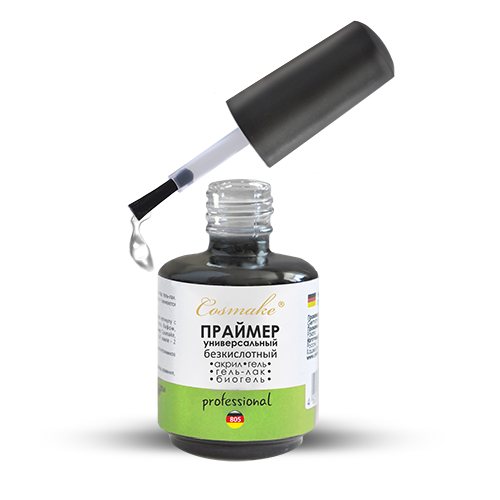
An acid-free primer is more gentle and less dangerous for the skin, but is also slightly inferior to an acid primer in terms of the effectiveness of adhesion of the material to the nail plate. This type of primer is recommended for use when applying gel extensions and coating nails with gel polish. It also removes oil from the nails, dries them and removes harmful microorganisms, forming a reliable connection between the scales of the upper layers of the nails and the artificial material.
Primer for gel polish and shellac
To cover nails with gel polish, the use of a primer is not necessary, provided that it stays on the nails for a long time and without chipping. Otherwise, to improve the adhesion of shellac to nails, it is recommended to use any acid-free primer or bonder.
Primer for gel nail extensions
When applying gel nail extensions to tips or forms, it is enough to use any acid-free primer. However, sometimes it needs to be applied 2 times to increase the reliability of the adhesion. Please note that when applying gel extensions to tips, you should avoid getting primer on them: this can lead to cracks. The primer is also applied when correcting nails, but only on the regrown part of the natural nail, avoiding contact with the skin.

Primer for acrylic nails
When extending nails using acrylic powder, it is recommended to use an acid primer as the most reliable in terms of adhesion of the nail surface to the artificial material. It does not affect the color of acrylic and reliably protects it from cracks and peeling, of course, provided it is used correctly.
How to use degreaser: precautions
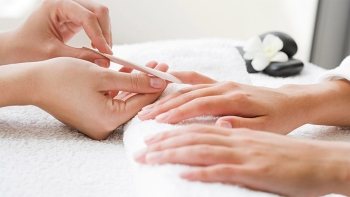
The degreaser is applied to the nails with a brush, which is provided in the bottle with the product. If there is none, wipe your nails with a cotton pad soaked in degreaser. Treat the nail carefully so as not to leave any areas uncovered by the degreasing liquid.
Like any chemical, degreaser must be used carefully and follow the instructions for use .
- Do not allow the degreaser to come into contact with the mucous membranes of the nose, mouth or eyes . Rinse thoroughly the area where the mucous membrane comes into contact with the product.
- Remember that the grease solvent has a rather pungent odor, to which you may be allergic .
- After use , carefully close the lid of the product and remove it away from sources of heat and bright light .
Ask the person you are going to cover if he or she suffers from allergic reactions to similar substances. When you use a product on yourself, make sure it is safe for you too. If you experience an allergic reaction to the degreaser, consult a doctor immediately.
How to use nail primer - instructions
How to apply primer to nails is usually indicated in the manufacturer's instructions and may differ slightly, but in general this process is standard:
- Use an orange stick or pusher to push back the cuticle from the nail plate.
- The natural shine is removed from the nails with a grinder file, and the dust is shaken off with a stiff brush.
- Next, the primer itself is applied. It only takes a little bit to apply it to the brush, squeezing it on both sides on the edge of the bottle and, if necessary, on a napkin. Place the brush in the center of the nail and let the primer distribute itself over the surface. In places where it can't reach, gently brush the brush, avoiding touching the skin. If this does happen, then you should rinse it thoroughly under running water. The primer should be applied very thinly: this way it will not flow anywhere and will work most effectively: a thick layer can prevent the scales from lifting from the upper layers of the nail.
- Next, you need to wait for the primer to air dry. This usually does not take more than a minute. You can tell that the bonder has already dried by the resulting pale coating on the nails. Sometimes the primer requires drying in a UV or LED lamp; this will definitely be indicated in the manufacturer's instructions.
- Next, the procedure for building up or creating a long-term gel polish coating is carried out using technology.
Answers to questions from a manicurist
Questions that are usually asked to specialists are: what is the difference between using a primer and a bonder, and what are the risks of refusing one of the products. Manicurists warn that the preparations have completely different qualities, and refusal to use one of them will negatively affect the result of the work.
The primer will reliably protect the nails from damage and bacteria, while the bonder is responsible for the durability of the artificial plate. It is not recommended to replace the preparations with ordinary glue - such experiments will cause rapid wear of the nails.
Manicurists also warn that when starting to build up plates or apply gel polish, you need to study the characteristics and types of products. If the nails are replete with cracks, damage, and delamination, it is better to use acidic compounds that have a beneficial effect on the tissue. Only in the absence of lesions can less aggressive drugs be used.
There are several more questions that arise for inexperienced girls who are starting to do their own nail extensions or apply gel polish for the first time. Let's try to understand them in more detail.
What is a dehydrator, will it replace a primer?
Another drug that you cannot do without when applying gel polish is a dehydrator. The necessary device has several useful qualities - normalization of water balance in tissues, a drying effect, and disinfecting properties.
You cannot do without a dehydrator if the sebaceous glands are too active - active particles quickly remove the greasy film. There are no aggressive ingredients in the composition, so you don't have to worry about irritation or side effects.
If an acid-based primer is used, a dehydrator is not necessary. The only indication is the activity of the glands that produce fat; if the plates are constantly covered with a greasy film, it is better not to risk it and apply a degreasing layer.
Is it possible to do without a primer?
Manicurists warn that you should not try to achieve good results by refusing to apply a primer. If germs and bacteria are allowed to remain under the artificial plate, microorganisms will begin to multiply at high speed, penetrate the tissue, cause damage and even fungal diseases.
Bonder and primer are recommended to be used both when building up artificial plates and before applying gel polish. It is these drugs that determine how long the coating will last.
Is the bonder dried in a lamp?
The basis of the product is a gel that does not dry out on its own in air. It is this substance that determines how effectively the artificial material will adhere to natural fabric.
How to use the drug? There won’t be any particular difficulties - apply the composition using rubbing movements with a thin brush and dry it in a lamp.
When starting a manicure, you should remember that whether you can achieve the desired results depends only on the use of special products and the strict sequence of their application. You should not experiment, try to replace drugs or speed up the process by giving up one of them. Such arbitrariness will lead to unexpected and undesirable results. Time will be wasted - the lifespan of the artificial turf will not exceed several weeks. Another trouble that awaits after mistakes are made is damage to the nails and even fungal diseases.
How to replace primer (nail degreaser)
The primer may not always be at hand or will run out at the most inopportune moment, so the question often arises of what can replace it. You can find advice on the Internet that regular nail polish remover with acetone is also suitable for degreasing nails . This life hack can really be used: acetone can dry out the nail plate, but you should pay attention to the fact that the product does not contain any oils - their presence will cause problems.
Vinegar or alcohol can also be used instead of nail degreaser , but no home remedy can lift the scales of the upper layers of nails to ensure high-quality adhesion of materials.
Boric acid as a nail degreaser or cologne is also cited by many as an alternative to primer in order to save on materials. However, it seems to me that this is not worth it: the price of the primer is quite adequate in terms of all materials for nail extensions and long-term gel polish coating. And its consumption is so minimal for one procedure that you shouldn’t neglect having a small bottle of nail bonder in your arsenal.
How the dehydrator works
The composition of the product is patented by leading companies and allows you to solve several problems at once, among which the following is of particular importance:
- fat removal;
- cleansing from dirt;
- drying the nail plate from excess moisture;
- restoration of acid-base balance;
- preventing the development of fungal diseases and inflammation of the cuticle area;
- creating a strong, long-lasting coating on the nails.
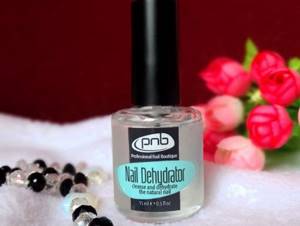
Dehydrator in a bottle
By using a dehydrator, the surface of the nail is disinfected, which completely prevents the appearance of harmful microflora under the artificial turf. Professionals who neglect to use a degreaser when applying a decorative layer can provoke infection under the coating, ruining the surface of the natural nail.
The use of the product allows you to ensure strong adhesion of the nail plate to the decorative layer. Nail design experts recommend using this range of products for any decorative nail treatment: be it gel or acrylic extensions, or applying transparent decorative varnish.
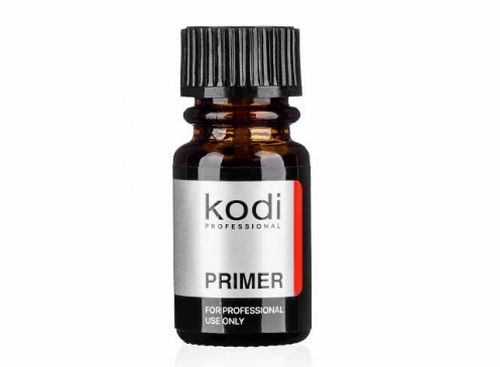
Nail primer Kodi
If you want to buy a good nail dehydrator, you should avoid products from the “no-name” category. Considering that one bottle lasts for a long time, the purchase is completely worth it.
The unique components included in the product help prevent such an unpleasant process as nail splitting, reducing their fragility.
Some believe that instead of a dehydrator, you can use a degreaser, mistakenly believing that these two products belong to the same category of materials.
FAQ
- Is it necessary to use a primer to degrease nails? The question often arises whether a nail primer is needed, and whether it is possible to do without it at all, because it is not included in gel polish starter kits. Answer: yes, but only if the coating holds up well without it. That is, by refusing to use a primer, you can get a shorter period of wearing gel polish. But for nail extensions, using a primer is a mandatory step.
- What is the difference between a primer and a nail base? This question may arise for beginners, since these are completely different concepts, although their function is very similar - ensuring reliable adhesion of the material to the surface of the nail. However, the primer is not an independent layer and does not dry in a lamp, while the base is part of a three-phase nail gel polish coating system, has a sticky layer, shine and polymerizes in a lamp. Its use is not necessary only if you use single-phase gel polishes (3 in 1 gel polishes), otherwise the technology for creating a long-term coating will be disrupted and the result may not be what you expect.
- Should nail primer be dried in a lamp? No, it is not necessary unless this is indicated in the instructions for use from the manufacturer. There are primers that need to be dried in a lamp, and this will definitely be indicated on the packaging.
- Which primer is better? I can’t undertake to recommend specific manufacturers, since I have tried a very limited number of them, but I would recommend buying a primer that does not require drying in a lamp - this will reduce your working time. Of those that I had, I liked the prep from Red Carpet Manicure the most: I have been using its small 10ml bottle for 2 years, and it dries in a matter of seconds - a white coating is visible on the nails immediately after applying the brush. Bonder from Ingarden dries in about 30 seconds and leaves a slight sticky residue - I use it with less durable gel polishes.
In this large article, I tried to sort out all the questions related to nail primer. If something remains unclear to you, ask in the comments.
What is the difference?
Despite some similarities in purpose and properties, there is a difference between primer and bond. The first product is used to prime the nail surface to clean and smooth it. It also degreases the plate, equalizes the pH balance, and removes excess moisture. Due to the properties and features of the composition, the adhesion of the plate to the artificial material is improved. The difference between the two products is not only in their use, but also in the drying requirements - the primer dries quickly naturally without a UV lamp. It is applied as a preparatory layer for bonder.
| Primer | Bond |
| Can be acidic or acid-free | The composition is no different |
| Dries naturally | Requires drying in a UV lamp |
| Prepares and levels the surface | Acts like double sided tape |
| For cleaning and degreasing | Provides adhesion of gel polish to the nail |
The main task of the bond is to ensure reliable fastening; the primer is more used for preparation and cleansing before extensions. The structure of the bonding agent is sticky and gel-like; this layer must be dried in a UV lamp, only then can you proceed to applying an artificial coating. Due to the nature of its action, bonder is also called double-sided tape.
A professional master uses both means in his work in stages. First, a primer is used to level and prepare the plate for the decorative coating. Only after that the nail is covered with blonde, ensuring reliable and high-quality adhesion of gel polish or artificial material.
Precautions when using primer analogues
The original nail primer is a fairly safe product that has passed clinical trials and is theoretically not capable of harming the nail plates or surrounding tissues. But if you use any drug to replace the primer, you must take safety precautions, since it is not completely known how this or that substance can affect the nails or skin.
How to stay safe when using homemade primer substitutes:
Use a product that can replace the primer as little as possible if your nails are too thin and brittle. It is recommended to use such preparations only in extreme cases, giving preference to specialized acid-free liquids for disinfecting, dehydrating and degreasing nails.
Be sure to do an allergy test before using any product for the first time. If we are talking about tea leaves or PVA glue, you will most likely be confident that your body will not show any unusual reaction
But acetone and boric acid are liquids with which you need to be careful. Therefore, apply a few drops of the drug to the inside of your wrist and wait 15-25 minutes
There should be no manifestations of allergies such as rash, redness, swelling or itching on the skin. In this case, the product can be used as an impromptu nail primer.
Even if you are not allergic to the substance with which you intend to replace the primer, you must ensure that it only gets on the nail plates and does not affect the skin of your fingers. The drug will not cause significant harm, but excessive dryness of the skin should still be avoided.
If in the process of performing a hygienic manicure you have damaged the integrity of the cuticle or skin around the nails, you do not need to use any products that can replace the primer within 24 hours. Contact of even the slightest amount of a caustic substance on injured tissue can cause pain. In addition, you can get a chemical burn, so you will have to wait a little before getting a manicure. If this is completely impossible, apply the polish without first preparing the nail plates, being careful not to touch the damaged areas. The decor will not last long, but it will perform its function within 2-4 days, and the damaged tissue will have time to heal. To make this happen as quickly as possible, use not a patch, but BF-6 medical glue, which will tighten the skin and promote its speedy recovery.
Nail art experts do not recommend getting too carried away with the use of products that can replace primers. Still, it is safer to use specialized preparations, the formulas of which were developed taking into account all the features and functional tasks inherent in primers.
What is the difference between the coatings?
How are primer and bonder similar, what is the difference between the drugs? Many girls, due to inexperience, believe that they have the same qualities. You should not make mistakes that will certainly affect the results of your work - despite similar qualities, the products have many differences.
What is the difference between the products, and what characteristics does each of them have? The main difference is in the composition. It is completely different, the active particles have different qualities. The primer serves to disinfect the nail plate, prevents the penetration of harmful microbes into the tissue, and protects against damage. Bonder increases the strength of the nail, prolongs the life of the manicure, and prevents delamination of the plate. Another difference from the primer is that it will require drying under UV rays.
The video describes the main differences between a bonder, primer and dehydrator:
How to choose?
Ultrabond Kodi, which is a special primer coating and is used for professional manicure, has proven itself well. Thanks to this product, 100% adhesion of the natural nail and gel polish occurs. The result of using this product is a strong attachment, as well as no peeling for at least 2-3 weeks. Ultrabond is the most popular among manicurists. Kodi is a product that does not harm the cuticle and does not have an unpleasant odor.
Effective acid-free products with similar functions are the substances presented below.
- RuNail professional primer.
- Bond-primer Aurelia. It is recommended for use on nails that are prone to splitting. This product does not harm the natural nail plate.
- Le Vole Ultra is distinguished by the durability of the manicure after its application. Reviews indicate ideal application of the substance.
Many masters cannot imagine their work without using a primer, as they consider it a means that has no alternative. If a situation arises that ultrabond is not at hand, then it can be replaced by degreasing with acetone or ordinary alcohol. In such a situation, you should not forget that replacing a professional substance with a improvised one will not guarantee a good result and will not provide good reliability during extensions. Acetone and alcohol will not be able to properly lift the nail scales, so there is a risk of rapid peeling.
The choice of this product is based on the financial capabilities of the buyer. But the main thing to remember is that the use of ultrabond is a guarantee of the durability and beauty of the manicure, so you should not skimp on such a product and a good manicurist.
To learn about what ultrabond is, why it is needed and how to use it, see the following video.
Basic properties and instructions for use: how long to dry the primer in a lamp

The popularity of nail extensions is becoming wider every day, which is why many girls are trying to figure out all the details in order to do everything on their own, and not run to the salon every time for the help of professionals.
What do manufacturers promise?
Anyone can figure it out and learn, there is nothing overly complicated in this process, so it is worth first assessing the properties and qualities that manufacturers endow with their products.

Any type of primer reliably and efficiently degreases the nail and significantly increases its adhesion to any coating. The composition can be saturated with a variety of microelements and vitamins, which makes it possible to keep your nail under the coating healthy and strong. A very important property of the primer is its antiseptic and bactericidal effect, which is very important. Only with this treatment can you be one hundred percent sure that fungus or other unpleasant things will not appear on your nails. No matter what anyone says, gel, as well as acrylic, have a destructive effect on the structure of the nail itself, since these are quite toxic substances
The primer should protect the nails from such exposure, creating a kind of barrier between them. When covering damaged or uneven nails with flaws, a primer is simply necessary, otherwise it is unlikely to achieve the desired result, and the extension or varnish will simply peel off and then fall off.
It is believed that by using a primer you can protect your nails from yellowing, which is what many representatives of the fair sex complain about, who have already tried nail extensions or gel coating.
